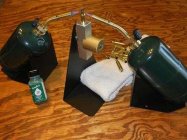I’ve been reading a lot on annealing. Whether it effects accuracy or not, methods etc.
I’ve also read a few times on here, of people saying improperly annealing brass is one of the worst things you can do.
I’m not a metallurgist, so forgive me, but how do you improperly anneal brass? I ask because I’m using a flame annealer (Ugly annealer) , and I use templaq 750 on the inside of the necks, and as soon as I see a color change I remove it, and that’s my setting.
But if one were using a flame annealer without some type of regulator, how would you get the same anneal each and every time, especially if the flame is also not in the exact spot each annealing. Does annealing have to be that precise, or does a certain temp have to be obtained and you’re good?
Thanks fellas
I’ve also read a few times on here, of people saying improperly annealing brass is one of the worst things you can do.
I’m not a metallurgist, so forgive me, but how do you improperly anneal brass? I ask because I’m using a flame annealer (Ugly annealer) , and I use templaq 750 on the inside of the necks, and as soon as I see a color change I remove it, and that’s my setting.
But if one were using a flame annealer without some type of regulator, how would you get the same anneal each and every time, especially if the flame is also not in the exact spot each annealing. Does annealing have to be that precise, or does a certain temp have to be obtained and you’re good?
Thanks fellas












